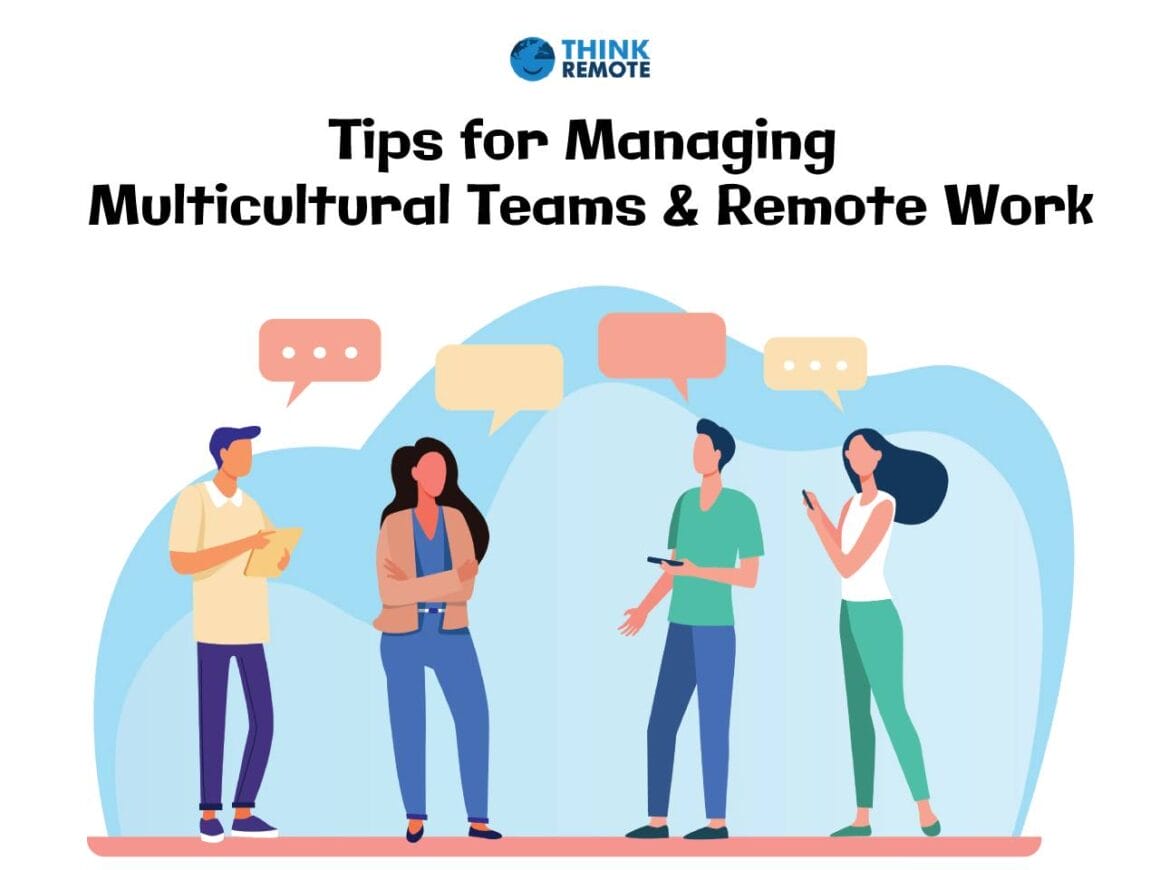Today’s increasingly global marketplace necessitates every team manager to learn how to lead remote multicultural teams as part of employee training. Globalization transformed how people work. While yesterday’s team leaders needed to understand personality differences and manage how members interact, today’s team leads require further managerial know-how and the ability to decode cultural differences to work effectively with colleagues, clients, and suppliers worldwide.
People from different cultures have different ideas about working effectively. These differences and how team leads can navigate them when managing multicultural teams are key to success.
At Think Remote, we know that fast-growing international companies are susceptible to bumping up against many of the above-mentioned issues, especially with remote work.
Below, we share tips and insights that we think are useful to those managing remote and multicultural teams.
Read: Remote Work Can Be The Key For An Inclusive Workplace
What is the Culture Map?
It’s essential to understand this before diving into our tips for managing multicultural teams. 
The following eight factors can help you map out how different cultures approach working together alongside:
- Communicating;
- Evaluating;
- Deciding;
- Leading;
- Trusting;
- Scheduling;
- Disagreeing;
- Persuading.
We invite you to map profiles alongside others from their culture. People should first fill out a questionnaire to determine their style of giving feedback, making decisions, and establishing trust in the workplace.
They then compare their results with people from different countries you have on your team. They can then choose the countries for which they wish to highlight the major differences and similarities along the eight culture map dimensions listed above.
Culture is more complex than communication strategies and decision-making styles. To get an accurate picture, you need to gauge cognitive, behavioral, and relational differences along the eight culture map dimensions. Only then can you understand and appreciate how to manage and navigate multicultural teams.
So now that you have a basic understanding of the culture map concept and how different cultures approach working together along the eight dimensions, let’s look at our tips for managing international teams.
Even if your team members come from cultures differently placed along the eight-dimensional spectrum, these tips will work!
1. Break The Language Barrier
Remember the story how God introduced different languages so people divide? 
The language barrier is the most common challenge between employees in a multicultural team, be it remote, or not. If you have people speaking different languages, you need to find a common language for everyone to use, as that’s the 101 foundation of communication.
- Build a database of key words, sentences, expressions, or technical definitions that everybody should know.
- Introduce a culture of patience and that repeating two, three, or ten times if needed, is okay.
- Implement processes for people to learn a certain language if somebody needs to catch up.
2. Get a Hold of Communication Styles

Different communication styles play a huge role in effective and efficient team communication and work.
Some cultures have high context, while others have low context:
- High context employees understand things explicitly, use non-verbal cues, and can read through the lines to find implied meanings. To name a few: Japan, Greece, and Arab countries.
- However, it would be best to clarify your communication when dealing with employees from low context cultures – spell out your communication explicitly, repeating it, and putting it in writing. To name a few: United States, Germany, England, and Scandinavian countries
- And then come multi-active cultures that mix both of the above. To name a few: Spain, Italy, France, Latin America.
It is critical to understand, map, and factor team members’ communication styles.
For example, you may need to be more explicit (setting up clear reminders about upcoming tasks, writing minutes and recaps or ending your presentations with clear takeaways and next steps).
Conversely, you may find yourself missing implied messaging from your team. There is no single correct approach to communicating with a multicultural group of colleagues.
So it’s better to understand and adjust your communication style and non-verbal cues as much as possible to match how each team member communicates. It’s a lot of effort, but it translates to greater productivity. Nonverbal communication reckons information beyond words, such as gestures, facial expressions, and all forms of body language.
It’s also good to have team members consider contextualized, culture-specific nuances for broader audiences. They should keep their language simple and concise, avoiding acronyms and specific non-verbal cues unless they explain what they mean.
For example, head nods, and hand gestures can convey opposite sentiments in different cultures. You wouldn’t want somebody to mean “yes” while others see it as a “no”, right? The same way remote work expectations differ from reality, so can different forms of communication.
Setting clear communication guidelines will ensure everybody embraces connectivity and does not fear personal interactions.
USA
Employees in the United States are well-known for providing overtly favorable feedback, using expressions such as: fantastic, fabulous, awesome, amazing. And by providing critical comments, they like communicating in writing if possible.
England
When appreciating or criticizing a coworker, Britons are often more indirect than their US counterparts. They respond to criticism with apologies that include adjectives such as: maybe perhaps, and probably.
Germany
Employees in Germany have a propensity to deliver constructive criticism in an open and honest manner, and they are less inclined to favorable comments.
France
When it comes to the workplace, French workers are more prone to provide either critical or helpful verbal criticism. They operate on the philosophy that “no news is good news” in terms of obtaining favorable feedback.
Brazil
The workforce of Brazil are noted for their ability to communicate in a manner that is indirect and implicit. Both positive and negative feedback are treated in the same manner under this rule.
Argentina
When compared to employees from other Latin American nations, Argentinian workers are regarded as being the most forthright in providing criticism. According to Meyer, this kind of conduct is likely to be seen as arrogance by the nations that are nearby, which increases the risk of violence.
Nigeria
Workers in Nigeria are well renowned for their extremely straightforward approach to offering feedback, which is highly unique for employees in other African nations.
Ghana
Ghanaian workers, similar to their counterparts in other African nations (with the exception of Nigeria), prefer to avoid open confrontation. They will inform a common buddy in order to provide someone constructive input about anything they have seen or heard.
3. Advocate Cultural Sensitivity
Cultural sensitivity during the interview and on-boarding process is a must just as it is in the workplace and work communication. It can help you understand and work with people from different cultures. 
Management needs to make sure that employees feel welcome and valued.
4. Introduce Safe Zones
The best way to successful multi-culture management is to have buffer zones for people to open up and address blockers in work and communication. We all need to talk, as questions, and find understanding in order to overcome issues, be it emotional or professional. 
Stay Away From Stereotypes
Language should never be used to belittle others or to promote oneself over the rest. Always be respectful and mindful of the fact that your words may affect your team or coworkers.
When working in a multi-cultural environment, you need to rely less on stereotypes to make judgments about your employees.
This argument isn’t really valid. When your employees are from Japan or France, that doesn’t mean they have to use French words, or that they have to do something in Japanese.
Treat your coworkers in the same manner that you want to be treated.
5. Nourish Empathy
A solid manager will always factor in time to sync with their team members to see how they’re doing, how they’re feeling about the company, both good and bad. This is how you build empathy, trust, respect, and loyalty.
We all need acknowledgement of our thoughts and feelings about the work we do.
One of the hardest things for humans to do is to practice empathy for others. While talking with your colleagues, practice being empathetic by focusing on what matters to them.
The ability to empathize is the ability to understand and relate to feelings of another person.
Understanding what your colleague is experiencing helps your relationship with them thrive. You’ll also improve your own empathy skills.
Read: Remote Networking: 5 Ways to Build Online Business Relationships
6. Calibrate Your Feedback Loop
Calibrate your feedback to match your team’s different approaches to evaluating, giving, and receiving feedback. For example, some cultures appreciate direct feedback, while others prefer it indirect. Soften your feedback if you have a direct approach, but your team likes an indirect one and vice versa.
Providing honest and constructive feedback is essential for your management and leadership duties. Your team deserves to know the truth about their work, whether negative or positive.
As a leader managing a multicultural team, especially one that’s scattered around the world, you should be cautious about evaluating your team members’ work.
Understanding that employees from different cultures and countries of origin have a unique way of giving and receiving feedback is key. Know how to provide constructive feedback, the least someone thinks it’s a negative or a personal attack.
If feedback styles cause friction with your team, explore a training program, organize a course, or workshop on how your organization expects to deliver feedback to avoid future problems.
The factors affected here are evaluating and communicating.
8. Time Zones & Project Management
Mismatch in time zones is especially valid for 100% virtual teams.
Factoring in time differences throughout your entire time is key to setting goals, deadlines, syncing to ongoing work, and ultimately efficiency. 
That’s why you should map the time zone throughout your entire team and have everybody use that when scheduling tasks, meetings, etc.
9. Establish Expectations Around Timing
Time is another issue that often causes rifts in diverse and multicultural teams. Some cultures plan their day and work according to the clock, while others take a more flexible approach. 
Employees who take a relaxed approach may find it perfectly acceptable to let meetings run over the scheduled time, or may show up late to a team meeting if they are not finished with a prior conversation.
However, this is bound to upset colleagues who prefer sticking to strict timetables. Some team members expect meetings to start on time, while others believe they have a grace period.
As a team leader, always clarify expectations around timing, whether it’s on your team or during the on-boarding process. Also, think about designating a timekeeper or implementing meeting agendas if your team has a significant discrepancy around timing. Something as simple as clarifying expectations around timing should help avoid friction and get everyone on the same page.
Also, some people need more time to better prepare and management needs to factor headspace, so everybody is okay. It could be time to practice speech or overcoming being shy.
10. Understand the Essence of Team Building

When building trust, you may need to organize more time for everyone to socialize outside of work and get to know each other, depending on whether your team members are relationship-based or task-based.
- For remote staff, you can hold various online games, be it trivia, business simulations, competitive challenges or even webinars.
- For physical meetups, it’s essential to organize dinners, excursions, activities, or drinks if most members are from relationship-based cultures. Of course, that’s applicable if you all work nearby.
If your team members come from task-based cultures, then focus on nourishing teamwork. You can build trust, provide collaboration opportunities with the right project management tools at your disposal or even consult a personal trainer for those who struggle closing the gap. You should also share goals, advance interdepartmental communication, advocate for your team, capitalize on diversity, and celebrate team achievements.
With most companies, many of the employees are in the middle between being task-based and relationship-based. Hence, it is equally essential to build rapport inside the office and outside of work.
As a result, you could dedicate a team-building budget. If you can have people come together physically, spend on outings such as dinners and drinks. For those far away, interactive meetings, slack games, other online games, team challenges outside official targets.
11. Know How to Persuade Your Team
Effective leadership relies on your persuasion abilities, so it’s crucial to adapt your persuasive techniques to a multicultural team.
When it comes to convincing your multicultural team, some people prefer an applications-first approach starting with tangible evidence. In contrast, others take the principles-first approach and lean more towards the theory.
Individuals who take an applications-first approach begin with a fact, opinion, or statement before adding concepts to explain or back up the conclusion as necessary. On the other hand, those who take a principle-first approach will begin by developing a complex concept or theory before presenting supporting facts, statements, or opinions
Be mindful of the arguments your team members appreciate because if you come at it from the wrong direction, you will not convince them to see your point or take your course of action.
Most people practice both applications-first and principles-first reasoning, but culture, education, company structure, and mindset will heavily influence habitual reasoning patterns.
Cultures determine the effectiveness of your requests and communications. It does not mean that your team culture differs entirely and members cannot see eye to eye.
However, when looking to persuade and influence your colleagues, it’s increasingly essential to take a responsible and ethical route when communicating and taking cultural matters into account.
Clarify your approach to communication and persuasion during on-boarding to ensure everybody is on the same page.
12. The Essence of Cross-Cultural Training
Consider holding a cross-cultural training or workshop if you have trouble managing your multicultural team. Training unlocks the endless potential of multicultural teams and empowers employees to continually adapt to diverse backgrounds, allowing them to modify their workplace behavior accordingly.
However, spending money and resources on training is not enough unless it translates into a positive on-the-ground impact and even company re-structuring. Remember the following principles when planning cross-cultural employee training:
- Although cultural knowledge has its limits, its adaptability is endless.
- Everyone on your team can actively learn during cross-cultural training.
- Collaboration is critical for effective cross-cultural training.
- Active cross-cultural training can turn diversity into an asset for your organization.
Strategies To Deal With Multi-cultural Challanges
- Adaptation – acknowledge cultural gaps publicly and seek ways to work around it.
- Structural intervention – change the shape of the team
- Managerial intervention – setting norms early or bringing in a higher-level manager
- Exit – removing a team member when other options have failed

The Bottom Line
Managing multicultural teams will be an increasingly essential skill to learn in the global marketplace. As a multicultural team leader, it’s pertinent to develop sensitivity to local customs, learn about your colleagues’ different cultural approaches to their work, and prioritize uniting your team by promoting mutual understanding and cohesion.
Once you learn to manage your multicultural team effectively, you will enjoy unparalleled innovation, collaboration, and unique perspectives to arising problems. Well-managed cross-cultural teams can be more effective than teams with homogeneous employee groups. Investing in cross-cultural training is worth the time and effort, allows you to become future-ready, and results in higher retention and better performance.






